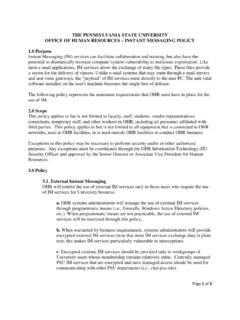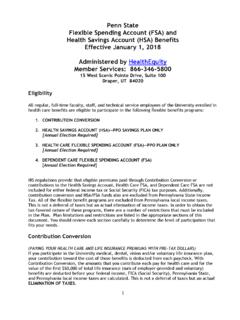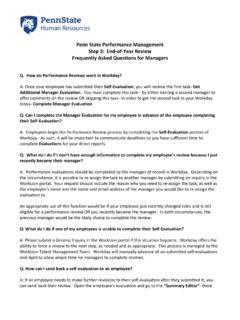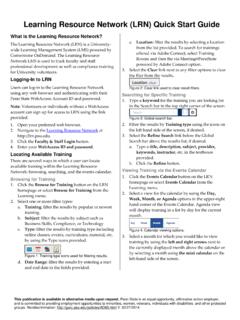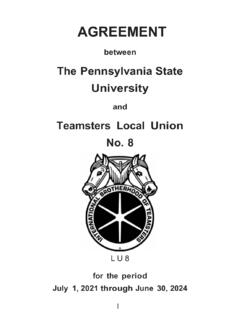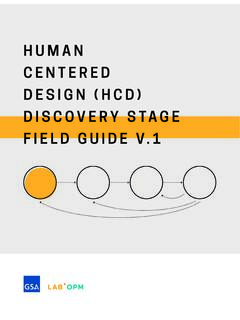Transcription of Performance Management: Giving and Receiving Feedback
1 Performance Management: Giving and Receiving Feedback Seminar for Supervisors Presenter: Stephanie Flanagan 814-863-4614. Fall 2017. 2017 The Pennsylvania State University. All rights reserved. Requests for permission to reuse these materials may be directed to: Workplace Learning & Performance at or 814-865-8216. Accommodation Statement/Alternative Media Statement The Pennsylvania State University encourages qualified persons with disabilities to participate in its programs and activities. If you anticipate needing any type of reasonable accommodation ( materials in alternate format, sign language interpreter, etc.)
2 To participate in Penn State Human Resources Talent Management program you plan to attend, please contact us as far in advance as possible so that we can have the appropriate reasonable accommodations in place for you. Contact Talent Management at 814-865-8216 (or to request reasonable accommodations or if you have questions related to requesting reasonable accommodations or the physical accessibility of the program site. This publication is available in alternative media on request . Giving & Receiving Feedback ii Talent Management Today's session will help you to: Gain understanding for how to effectively give and receive Feedback Identify your role and responsibilities related to Giving and Receiving Feedback Familiarize yourself with Feedback models and best practices During this session I will continue to provide information about Penn State's Performance management program and review the immediate next steps in the process.)
3 Giving & Receiving Feedback 1 Talent Management The Performance Management Cycle 1. Setting Goals and Expectations Developing Employees (Ongoing). 3. Appraisal & 2. Ongoing Reward Review and Feedback Coaching Setting Goals & 1. Clearly communicate expectations re: job Expectations responsibilities and competencies (skills) and behaviors 2. Communicate how individual goals align with department and organization goals 3. Help your employees set clear, measurable Performance goals Ongoing 1. Holds people accountable for meeting Review and Performance goals and objectives Feedback 2.
4 Provides constructive Feedback to help staff improve Performance 3. Takes appropriate action to address poor Performance Appraisal & 1. Conducts thorough annual Performance reviews Reward 2. Assesses individuals fairly 3. Differentiates high performers appropriately Giving & Receiving Feedback 2 Talent Management Roles in Giving and Receiving Effective Feedback Staff Member Monitor own Performance , seek Performance information, apprise supervisor of successes, shortcomings, and needs Act on Feedback received Supervisor Provide clear Feedback on an ongoing and often informal basis Ensure that staff member understands expectations Shared (Staff Member and Supervisor).
5 Agree upon a joint Feedback process ( , when and how Feedback will be exchanged on a one-on-one basis). Assume best intentions Institution Create a consistent language for getting and Giving Feedback Establish a No Fear culture where staff can feel comfortable sharing and Receiving frank Feedback Ensure supervisors model a Feedback culture Giving & Receiving Feedback 3 Talent Management The Performance Management Cycle: Ongoing Feedback and Coaching Feedback has a direct impact on our work: Gives us specific information to help us improve Makes Performance expectations clear from the start Heightens efficiency by reducing resentment, buildup, etc.
6 Strengthens relationships Benefits of Positive Feedback Gives clarity to the employee about good Performance . Creates enthusiasm. Builds confidence and self-esteem. Increases appropriate risk-taking and innovation. Demonstrates care and involvement. Makes an employee feel acknowledged. When Positive Feedback is appropriate When used to recognize specific job Performance that has met and/or exceeded expectations. (It reinforces and motivates.). Example of Positive Feedback : The budget estimates you presented at the last staff meeting were very detailed and gave us good criteria for decision-making.
7 Benefits of Developmental Feedback It lets people know how to execute a task more effectively. It steers actions; communicates what needs to change. It increases the person's self-awareness. It is the foundation of all development. It gives a bigger picture to the employee. When Developmental Feedback is appropriate When used to help an employee monitor and correct his or her own behavior. Example of Developmental Feedback : My expectation was that you would provide us with more details on the event budget. Because we didn't have enough information, we won't be able to make our final decisions until later this week.
8 What can you do to ensure that we will have the correct information? . Giving & Receiving Feedback 4 Talent Management YOU. Feedback Reflection: Write the initials of the people that you work with in the shapes provided, including direct reports, peers, your manager, customers/clients, etc. Then for each person, answer the questions: Are you comfortable providing them with direct, constructive Feedback ? If so, draw a solid arrow from you to their shape. If not, draw a dashed arrow. Are you comfortable Receiving direct, constructive Feedback from them?
9 If so, draw a solid arrow from their shape to you. If not, draw a dashed arrow. What does your reflection tell you? Giving & Receiving Feedback 5 Talent Management Feedback Framework: Feedback is an essential component of a learning and Performance culture. The framework assists in preparing to deliver Feedback effectively. Feedback is . Most beneficial if on-going (which ensures no surprises). Intended to support employee Performance and development Helpful and applies to both positive and constructive situations Copyright 2003 by The Segal Group, Inc.
10 , the parent of The Segal Company which includes its division, Sibson Consulting. All rights reserved. Used with permission by Sibson Consulting. Giving & Receiving Feedback 6 Talent Management Let's assume you are Jason's supervisor and have some positive Feedback to provide: Giving & Receiving Feedback 7 Talent Management Let's assume you are Anna's supervisor and have some constructive Feedback to provide: Examples used with permission from Sibson Consulting Giving & Receiving Feedback 8 Talent Management Using the Feedback Framework: It's your turn to try!

